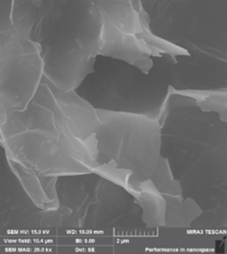Graphene NMP Dispersion, Purity: 99.5%, Graphene: 0.5 wt%
Graphene NMP Dispersion Purity: 99.5% Graphene: 0.5 wt% refers to a liquid dispersion of graphene in N-Methyl-2-pyrrolidone (NMP) solvent.
Properties and Benefits of Graphene NMP Dispersion:
- Electrical Conductivity:
- The graphene in the dispersion retains its excellent electrical conductivity properties, making this dispersion suitable for use in electronic applications such as conductive inks, flexible electronics, and sensors.
- Stability:
- The use of NMP as a solvent helps keep the graphene particles evenly dispersed, preventing them from aggregating. This ensures that the material remains stable for longer periods, making it suitable for industrial processes and applications requiring stable dispersions.
- Improved Mechanical Properties:
- Graphene is known for its extraordinary mechanical strength. When used in composites, the dispersion can enhance the strength and durability of the resulting materials. The liquid form of the graphene allows it to be more easily incorporated into materials, such as plastics or composites.
- Thermal Conductivity:
- Graphene has high thermal conductivity, and the dispersion can be used in applications requiring heat management, such as thermal pastes, heat sinks, or thermal interface materials.
- Chemical Reactivity:
- The edges of graphene particles, especially in dispersion, can be chemically reactive, allowing the material to be functionalized for use in specific applications, such as catalysis, sensors, and biosensors.
- Compatibility with Other Materials:
- Graphene NMP dispersions can be easily incorporated into various other materials to improve their electrical, mechanical, and thermal properties. This makes the dispersion useful in applications like composite materials, coatings, and inks.
Applications of Graphene NMP Dispersion:
- Electronics:
- Graphene dispersions in NMP are widely used in printed electronics, conductive inks, and flexible electronics, where graphene’s high conductivity and mechanical properties are critical.
- Energy Storage:
- The dispersion can be used in the production of supercapacitors, batteries, and fuel cells, where graphene improves charge storage capacity, charge/discharge rates, and cycle stability.
- Composite Materials:
- When added to polymers or other materials, the dispersion can improve the mechanical strength, thermal conductivity, and electrical conductivity of the resulting composites. This makes it useful in applications in aerospace, automotive, and construction industries.
- Coatings and Paints:
- Graphene dispersions can be applied as coatings to improve conductivity, strength, and corrosion resistance. The dispersion can be used in anti-static coatings, conductive paints, or protective coatings.
- Sensors:
- Due to its high surface area and reactivity, graphene is used in sensors and biosensors for detecting gases, chemicals, and biological molecules. The dispersion form makes it easy to apply graphene in thin layers on substrates for these applications.
- Nanocomposites:
- Graphene NMP dispersions can be incorporated into a variety of nanocomposite materials, enhancing their mechanical, thermal, and electrical properties for use in advanced materials and high-performance applications.
Summary:
Graphene NMP Dispersion Purity: 99.5% Graphene: 0.5 wt% refers to a liquid suspension of high-purity graphene (99.5%) in the solvent N-Methyl-2-pyrrolidone (NMP) at a concentration of 0.5 wt%. This dispersion retains graphene’s exceptional electrical, thermal, and mechanical properties, making it suitable for use in electronics, energy storage, composites, coatings, and sensors. The use of NMP ensures that the graphene particles remain stable and well-dispersed, allowing for easier integration into various applications.
| Graphene Purity (%) |
99,5 |
| Graphene Thickness (nm) |
0,6-1,2 |
| Diameter (µm) |
2,0-12,0 |
| Appearance |
Black Liquid |
| Concentration (wt%) |
0.5 (mg/ml) |
| Specific Surface Area (m2/g) |
600-1200 |
| Elemental Analysis (%) |
C O
99,6 <0,4 |
| Surfactant |
YES |
SEM Image of Graphene

FTIR Spectrum of Graphene Produced by Liquid Phase Exfoliation

Application Fields
1) XPS patterns of Single Layer Graphene
2) Catalyst
3) Supercapacitors
4) Solar energy
5) Graphene semiconductor chips
6) Conductive graphene film
7) Graphene computer memory
8) Biomaterials
9) Transparent conductive coatings








